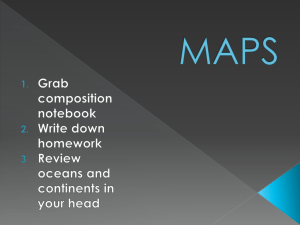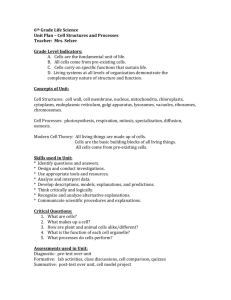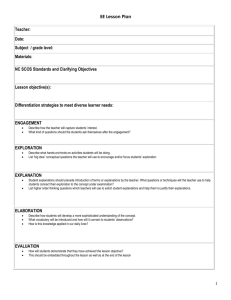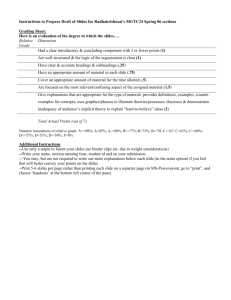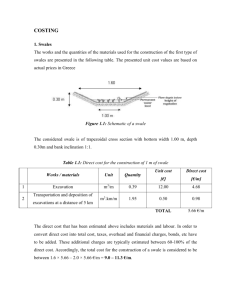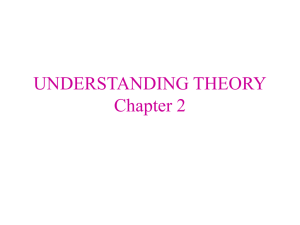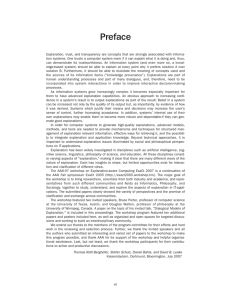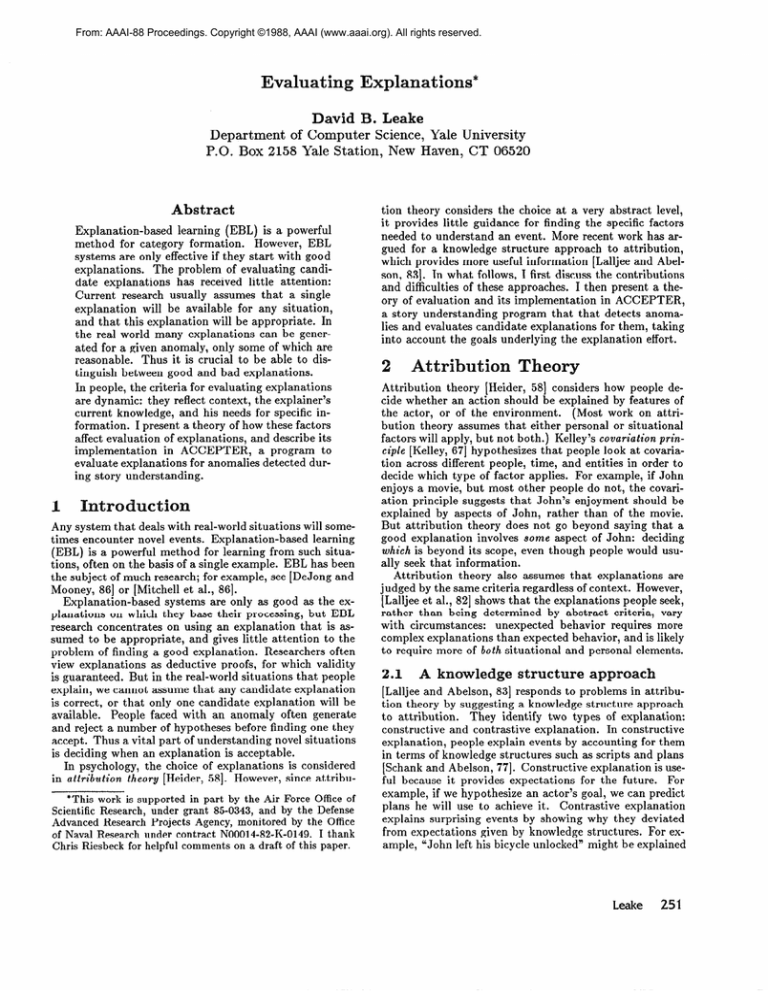
From: AAAI-88 Proceedings. Copyright ©1988, AAAI (www.aaai.org). All rights reserved.
Evaluating
Explanations*
David B. Leake
Department of Computer Science, Yale University
P.O. Box 2158 Yale Station, New Haven, CT 06520
Abstract
Explanation-based learning (EBL) is a powerful
method for category formation.
However, EBL
systems are only effective if they start with good
explanations. The problem of evaluating candidate explanations has received little attention:
Current research usually assumes that a single
explanation will be available for any situation,
and that this explanation will be appropriate. In
the real world many explanations can be generated for a given anomaly, only some of which are
reasonable. Thus it is crucial to be able to distinguish between good and bad explanations.
In people, the criteria for evaluating explanations
are dynamic: they reflect context, the explainer’s
current knowledge, and his needs for specific information. I present a theory of how these factors
affect evaluation of explanations, and describe its
implementation in ACCEPTER,
a program to
evaluate explanations for anomalies detected during story understanding.
41
Any system that deals with real-world situations will sometimes encounter novel events. Explanation-based learning
(EBL) is a powerful method for learning from such situations, often on the basis of a single example. EBL has been
the subject of much research; for example, see [DeJong and
Mooney, 861 or [Mitchell et al., 861.
Explanation-based systems are only as good as the explanations on which they base their processing, but EBL
research concentrates on using an explanation that is assumed to be appropriate, and gives little attention to the
problem of finding a good explanation. Researchers often
view explanations as deductive proofs, for which validity
is guaranteed. But in the real-world situations that people
explain, we cannot assume that any candidate explanation
is correct, or that only one candidate explanation will be
available. People faced with an anomaly often generate
and reject a number of hypotheses before finding one they
accept. Thus a vital part of understanding novel situations
is deciding when an explanation is acceptable.
In psychology, the choice of explanations is considered
theory [Heider, 581. However, since attribuin attribution
*This work is supported in part by the Air Force Office of
Scientific Research, under grant 85-0343, and by the Defense
Advanced Research Projects Agency, monitored by the Office
of Naval Research under contract N00014-82-K-0149.
I thank
Chris Riesbeck for helpful comments on a draft of this paper.
tion theory considers the choice at a very abstract level,
it provides little guidance for finding the specific factors
needed to understand an event. More recent work has argued for a knowledge structure approach to attribution,
which provides more useful information [Lalljee and Abelson, 831. In what follows, I first discuss the contributions
and difficulties of these approaches. I then present a theory of evaluation and its implementation in ACCEPTER,
a story understanding program that that detects anomalies and evaluates candidate explanations for them, taking
into account the goals underlying the explanation effort.
Attribution
6?0ry
Attribution theory [Heider, 581 considers how people decide whether an action should be explained by features of
the actor, or of the environment.
(Most work on attribution theory assumes that either personal or situational
factors will apply, but not both.) Kelley’s covariation principle [Kelley, 671 hypothesizes that people look at covariation across different people, time, and entities in order to
decide which type of factor applies. For example, if John
enjoys a movie, but most other people do not, the covariation principle suggests that John’s enjoyment should be
explained by aspects of John, rather than of the movie.
But attribution theory does not go beyond saying that a
good explanation involves some aspect of John: deciding
ulhich is beyond its scope, even though people would usually seek that information.
Attribution theory also assumes that explanations are
judged by the same criteria regardless of context. However,
[Lalljee et al., 821 shows that the explanations people seek,
rather than being determined by abstract criteria, vary
with circumstances: unexpected behavior requires more
complex explanations than expected behavior, and is likely
to require more of both situational and personal elements.
2.4, A knowledge structure approac
[Lalljee and Abelson, 831 responds to problems in attribution theory by suggesting a knowledge structure approach
to attribution.
They identify two types of explanation:
constructive and contrastive explanation. In constructive
explanation, people explain events by accounting for them
in terms of knowledge structures such as scripts and plans
[Schank and Abelson, 771. Constructive explanation is useful because it provides expectations for the future. For
example, if we hypothesize an actor’s goal, we can predict
plans he will use to achieve it. Contrastive explanation
explains surprising events by showing why they deviated
from expectations given by knowledge structures. For example, “John left his bicycle unlocked” might be explained
Leale
251
in terms of goal reversal: perhaps rather than having the
normal goal of wanting to protect it, he actually wanted
to get rid of it.
Explanation-based learners like GENESIS [Mooney and
DeJong, 85) do constructive explanation: they try to link
observed facts to motivating goals and the plans that
achieve them. These plans are then learned for future use.
However, such systems do not address the problem of focusing explanation: motivations are not always the most
useful aspect of a situation to explain. Nor do they address
the problem of judging an explanation’s acceptability.
IACCEPTER detects anomaly 1
Problem
description
1
1
f
Explanation accepted
Figure 1: ACCEPTER’s evaluationcycle
added to the system’s beliefs, and the explanation is stored
in memory to be available for explaining future anomalies.
ACCEPTER implements a theory of what should be explained and what constitutes a good explanation. It is a
story understanding program that detects anomalies and
evaluates candidate explanations for them.
ACCEPTER’s domain is incidents of unexpected death;
its primary example is the death of the racehorse Swale.
Swale, a star racehorse, was found dead a week after winning an important race. People generated many explanations of his death, but the actual cause was never found.
Many of the explanations ACCEPTER evaluates were suggested by deaths that Yale students were reminded of when
told about Swale. One student was reminded of the death
of the runner Jim Fixx, who died when jogging over-taxed
a hereditary heart defect. Although that explanation does
not apply directly (since Swale was not jogging before his
death), it suggests that Swale might have had a heartattack because his racing overtaxed a heart defect. Another student was reminded of the death of Janis Joplin,
who died of a drug overdose. This suggested the fanciful
explanation that Swale took drugs to escape the pressure
of stardom, and died of an overdose. It also led to the
less frivolous possibility that Swale died from an accidental overdose of performance-enhancing drugs.
ACCEPTER grew out of the evaluation module of the
SWALE system [Kass et al., 861. SWALE uses a casebased approach to generate explanations, and addresses
issues of retrieval from memory, revision, and evaluation
of explanations. ACCEPTER concentrates on evaluation,
performing a wider range of tests and using finer-grained
criteria than used for evaluation in SWALE. ACCEPTER
maintains a library of explanations, and uses a problem
characterization as the index to retrieve possibly-relevant
explanations of anomalies. However, the final selection of
explanations to evaluate is done by the user of the program,
as is revision of problematic explanations.
Expectations
from pre-stored schemas guide ACCEPTER’s routine processing. When it detects conflicts
with these expectations, it retrieves candidate explanations. The user can select one of these or interactively
The resultant explanation is
define a new explanation.
then evaluated, and problems are identified. For example,
the explanation Swale died from jogging + heart deject is
rejected because horses don’t jog. The user then has the
option of choosing a new explanation or interactively revising to fix the problem. (E.g., replacing jogging by horseracing as the source of exertion.) ACCEPTER repeats the
evaluation and revision cycle until it accepts an explanation. [See figure 1.) Beliefs in the accepted explanation are
252
Cognitive Modeling
3.1
3.1.1
ACCEPTER’s
Evaluation
Criteria
Relevance to an anomaly
EBL systems for story understanding explain in order to
generate new schemas. In most systems, the explanations
generated are completely determined by the event being
explained: the reason for explaining does not influence the
explainer’s focus. But when people explain, they focus on
filling gaps in their knowledge: rather than simply asking
why an event happened, they try to explain the aspects of
the situation that they found anomalous.
For example, people hearing for the first time about a recall of cars would explain different things depending on the
circumstances. If the recall is mentioned during a conversation about greedy companies’ refusal to accept responsibility for problems after sale, the admission of a defect
would be surprising. A useful explanation would reconcile
it with old beliefs: perhaps the company thought lawsuits
would cost more than the repairs. If the recall is mentioned during a discussion of the excellent quality control
of the company, an explanation might address how the defect slipped through the company’s checks. In this context,
explaining motivation for the recall would not be relevant.
What needs to be explained depends on the understander’s expectation failure [Schank, 821; the same event
can cause different expectation failures in different contexts. ACCEPTER requires that candidate explanations
focus on the features of the situation that conflicted with
its expectations. An explanation is relevant to the expectation failure if it identifies the faulty beliefs on which the
expectation was based, and shows how revision of those
beliefs accounts for the surprising aspects of the situation.
By identifying the faulty beliefs underlying the bad expectation, it can correct them and form more accurate expectations in similar future situations. By accounting for the
aspects of the situation that were surprising, it can better
understand the current case. (For discussion of the need
to explain both anomalous features of a situation and why
the bad expectation was generated, see [Leake, 881.)
3.1.2
Believability
of an explanation
ACCEPTER’s explanations are instantiated explanation
patterns (XPs) [Schank, 861, dependency networks tracing
how a belief can be inferred from a set of hypotheses. To
verify an explanation, the system checks both the plausibility of the hypotheses it involves, and the inferences connecting them. Links between beliefs are checked against
inference rules in ACCEPTER’s rule library. When an explanation uses a link that is unknown to the system, the
program asks the user to supply a chain of known rules supporting the connection. For links involving known rules,
it verifies that stored restrictions on rules’ role-fillers are
satisfied by the rule’s antecedents and consequents.
Although AI systems have often used probabilistic approaches to judge the plausibility of hypotheses (e.g.,
[Shortliffe, 76]), knowledge of relevant probabilities is unlikely to be available in many real-world situations. [Kahneman et al., 821 demonstrates that rather than using probabilities, people judge plausibility by seeing how well a
hypothesis matches common patterns. ACCEPTER uses
a similar approach: when a hypothesis matches no existing belief, it is checked against stereotyped knowledge. To
control inferencing done during verification, ACCEPTER’s
consistency checking is highly constrained. Rather than attempting to check all ramifications of a fact, it checks only
for discrepancies between the fact and the closest matching
structures in memory. Thus verification is strongly memory based: the verification process is the same process used
for integration of new facts into memory.
Because the basic understanding process is used to test
hypothesized facts, the checks used to fit a fact into a
schema must be finer-grained than in most understanders.
ACCEPTER uses the algorithm below to integrate facts
and hypotheses into memory:
Check whether input fact is already in memory:
If the input refers to a state, object, or event that is already known, its features are compared with the features
in memory. Any conflicting features are judged anomalous.
Pf fact is not already known, check whether it satACCEPTER’s
process for unisfies an expectation:
derstanding routine facts is modeled on [Cullingford, 781.
Events are understood by fitting them into Memory Qrganization Packets (MOPS) [Schank, 821, which are schemas
providing stereotyped expectations to guide understanding. For example, the stereotyped events involved in eating
in a restaurant might include first waiting for a table, then
sitting down, ordering, receiving food, etc. If an input fact
satisfies the expectations provided by an active MOP, it is
stored in memory under that MOP ([Schank, 821, [Kolodner, 841, [Lebowitz, SO]), and expectations for the MOP’s
next scenes are activated. For example, the fact that Swale
raced at Belmont places Swale in the racing phase of the
MOP M-racehorse-life, and generates the expectation that
he will race for a few years, live at the stud farm for a few
years, and then die.
When an input only partially matches an expectation,
the conflicts are detected as anomalous.
For example,
when ACCEPTER installs the event of Swale’s death in
Swale’s M-racehorse-life, the death is earlier than predicted
by M-racehorse-life, which expects racehorses to die a few
years after the end of their racing careers. Consequently,
the death is considered anomalous.
If fact was not expected, instantiate a knowledge
structure that would have predicted it: When an input fact is irrelevant to active expectations, ACCEPTER
attempts to instantiate a new MOP to accept it. For example, when the system begins to process the story of Swale,
it places Swale in memory by instantiating the MOP Mwith Swale as its actor.
ACCEPTER
also accounts for facts in terms of role
themes [Schank and Abelson, 771. Role themes represent
stereotyped knowledge about the plans and goals associated with actors in certain societal roles. For example,
we expect that a policeman will direct trafffc, investigate
crimes, etc. If a hypothesized action is part of its actor’s
role theme, the role theme provides confirmation for the
action’s likelihood. Conflicts are noted as anomalies.
racehorse-life
Check whether fact’s role-fillers are consistent with
normal stereotypes and restrictions:
ACCEPTER’s
MOPS include stereotyped information on common types
of role-fillers, and particular role-fillers are checked against
those stereotypes. For example, ACCEPTER represents
that the filler of the jogger role in M-jogging is usually
human. When the system tries to apply the Jim Fixx
XP to Swale’s death, it detects a problem because horses
do not fit the stereotype for joggers. These checks detect
problems, but do not give confirmation: although joggers
are usually human, the fact that a hypothesized jogger is
human does not make his jogging more likely.
Check for predisposing circumstances:
Predisposing circumstances can provide partial confirmation of a
fact. ACCEPTER’s MOPS include information about the
circumstances that make them more likely to occur: For
includes the information
example, its MOP M-heart-attack
that high-strung people are likely to have heart attacks.
When ACCEPTER knows of features that predispose an
actor to fill a particular role, it checks whether the hypothesized role-filler is known to have those features, or if
they can be assumed from property inheritance. (To avoid
excessive inferencing, it does not try to derive the features
from other information.)
ts
connect
actions
to
actor
goals:
ACCEPTER’s approach to ascribing motivations is modeled
on PAM. [Wilensky, 781. Since plan recognition is much
more costly than doing the preceding checks, it is only used
when they cannot account for the input.
Try
3.13
Information
given by an explanation
Believable explanations are still unsatisfying if they fail
to provide sufficient information.
Needs for information
depend on the explainer’s goals and the plans available to
achieve them. For example, when someone without mechanical skills wants to explain a car not starting, he only
needs to determine whether the car actually has mechanical problems (e.g., the problem might only be extremely
cold weather). If the problem is mechanical, he can pass
the problem to a mechanic. But the mechanic needs a more
detailed explanation than “mechanical problems,” since he
needs to identify which part to change or adjust.
ACCEPTER evaluates explanations in light of actors’
needs to respond to new situations.’ The system can now
evaluate explanations in terms of standard information
required by the veterinarian’s or detective’s role themes.
When a vet explains an animal’s death, he looks for a medical cause acceptable for an autopsy report. A detective,
‘For discussion of evaluation for other purposes, see [Keller,
871 and (Kedar-Cabelli, 871.
Leale
253
whose role theme requires identifying foul play, investigates
until the problem is either traced to a criminal plan or to
innocent causes. For each role theme, ACCEPTER stores
the following characterization of theme-related needs for
information:
e A list of types of anomalies whose resolution is important to the theme.
o For each important anomaly, criteria for deciding if
an explanation provides adequate information for a
standard theme-based response.
Examples of anomalies important to a vet are animals’ unexpected changes of health, physical changes (e.g., weight
loss) and behavioral changes (such as loss of appetite);
they might be signs of a health problem that needs treatment. Anomalies important to a detective include surprising deaths and violent acts; he would trace the cause of
a surprising deterioration of health to find whether it was
due to natural causes or foul play. For a violent act, he
would investigate the actor’s motivation to see if the act
was unacceptable or justified (e.g., self-defense).
If an anomaly is important to its active theme, ACCEPTER tests the most believable explanation to see if it
provides adequate information for a theme-based response.
It checks by matching the explanation to a stored template
for the needed type of information. This template is an
abstract form of XP: its belief-support chain can specify
classes of nodes and links rather than specific nodes and
links. For example, the template for the vet’s explanation
of changes in health specifies the explanation must connect
a negative health change, via a sequence
of any number of
physical-result links, to a medical cause (which is restricted
to being an instance of disease, trauma, organ-failure, or
administering medication).
Matching against the template serves two purposes: it
verifies the structure of the explanation’s belief-support
section, confirming that the XP has the needed causal
structure, and binds variables in the template to specific
aspects of the explanation that a theme-driven actor needs
to know. For example, matching the vet’s explanation template to an XP can bind the template’s variable cause-ofhealth-change to a specific disease. Given identification of
the disease, the vet could decide on a treatment.
While ACCEPTER’s knowledge of theme-related needs
for information is pre-compiled, a future goal is to supplement this knowledge with the ability to judge dynamically
on the basis of active goals.
3.2 Finding an acceptable explanation
ACCEPTER
evaluates candidate explanations until it
finds a relevant one with confirmable hypotheses.
If it
exhausts the candidate explanations before finding one, it
accepts the best candidate from the explanations it has
tried (provided its hypotheses do not conflict with system beliefs).
Ranking of explanations is based on the
believability of their weakest hypotheses: an explanation
is favored if the likelihood of its weakest hypotheses is
greater than that of the weakest hypotheses of competing explanations. 2 If two explanations’ weakest hypotheses
2Bypotheses’likelihood rating depends on the type
ofconfirmation or problem found when integrating them into memory.
254
Cognitive Modeling
have equal strength, ACCEPTER favors the explanation
with the fewest hypotheses of that strength. If both have
the same number, the next-weakest hypotheses of each
explanation are compared, until a difference is found at
some level of belief strength. (If the comparison reaches
previously-believed facts, the program considers the explanations equally likely.) The best explanation is then
checked to see if it gives adequate information.
If not,
ACCEPTER prompts the user for elaboration.
ACCEPTER’s
emphasis on using patterns to suggest
likely hypotheses differs from the approach to choosing
between explanations in [Pazzani, 881. Pazzani’s strategies include avoiding explanations that predict events that
were not observed, and preferring explanations that account for more of the observed features of the situation.
Applying these strategies may require considerable inference, and such strategies also require both that relevant
effects be observeable, and that observed features be restricted to relevant effects. Real-world situations often require explaining when effects cannot be verified, and where
the set of features to account for is uncertain. For example, if a guest is late, and radio news has reported some
drug-related arrests, the delay could be explained by the
guest’s being arrested or by heavy traffic. Although the
arrest accounts for both the news report and the delay, for
most guests we would still favor the later explanation.
4
Sample ACCEPTER
Output
ACCEPTER starts with a library of nine XPs. It runs on
two stories, the death of Swale and the death of basketball
star Len Bias. For Swale’s death, input is a conceptual
representation of:
Swale was a successful racehorse. Swale won the
Belmont Stakes. Swale died a week later.
The early death contradicts expectations for horses’ lifespans, so ACCEPTER attempts to explain the death. In
the output below, ACCEPTER evaluates the explanation
Swale died because the exertion
defect from two perspectives.
of racing
over-taxed
a heart
view
Checking whether the explanation ia relevant to
[PREMATURE-EVENT
EXPECTATION-SOURCE- SWALE’s RACEHORSE-LIFE
EARLY-EVENT - SWALE’s DEATH]
Confirmed It would account for the surprising
aspect of the event.
A vet’s
Checking believability of the explanation.
SWALE’S HORSE-RACE matches previous beliefs.
Although the explanation assumes HEART-ATTACK,
which is unconfirmed, the fact that SWALE has
HIGH EXCITABILITY is a predisposing feature
that supports the assumption.
The explanation assumes the HEART-OF SWALE’s role
in HEREDITARY-DEFECTIVE-HEART.
ACCEPTER’s confirmation
classes follow (in order of decreasingconfirmation):
confirmed
by priorbeliefs
or active
expectations;
supportedby predisposing
circumstances;
unsupported,
but withoutproblems;
conflicting
with patterns,
beliefs,
etc.A
futuregoalisto determinea finer-grained
ranking.
This hypothesis is unsubstantiatedbut possible.
Believability
- ie ACCEPTABLE.
[Kedar-Cabelli, 871 Kedar-Cabelli, S.T., Formulating Concepts According to Purpose, Proceedings
of the Sixth
SWALE'S DEAD HEALTH is important to a vet.
Checking whether the explanation traces
SWALE's DEAD HEALTH to the disease, organ failure or
physical cause responsible.
Explanation hypothesizes the ORGAN-FAILURE:
HEART-ATTACK. It also shows a physical-result
chain between the cause end SWALE's DEAD HEALTH.
Conclusion: explanation is ACCEPTABLE.
AAAI, Seattle, WA, July 1987, pp. 477-481.
[Keller, 871 Keller, R. M., Defining Operationality for
Explanation-Based
Learning, Proceedings
of the Sixth
A detective’s view
Since the anomaly is an unexpected death, the explanationisimportant to a detective.
His testsfor relevance
and believability are the same as the vet’s, but he needs
different information, as shown by the output below:
SWALE'S DEAD HEALTH is important to a detective.
Checking whether the explanation traces
SWALE's DEAD HEALTH to natural
causes,
to an
accident, or to a crime end suspect.
Explanation hypothesizes the NATURAL-CAUSE:
Conclusion
Explanation-based
systems rely on having a good explanation of each novel situation they deal with. In most realworld situations, an entire range of explanations can be
built for any phenomenon; it is important to know whether
a satisfactory explanation has been generated.
This evaluation cannot be done in the abstract: it, must
be influenced by what the explainer knows and needs to
learn. When expectation failures reveal gaps in its knowledge, ACCEPTER augments its knowledge by explaining.
by checking
It, judges relevance of candidate explanations
if they address the surprising aspect of the situation. It
checks believability based on whether an explanation’s hypotheses account for the event, in terms of prior beliefs
and known patterns. Finally, it, evaluates detail in terms
of the system’s needs for information to deal with the new
situation in accordance with particular goals.
efE?rences
[Cullingford, 781 Cullingford,
Understanding
R., Script Application:
Comof Newspaper
Stories, Ph.D. Thesis,
Yale University, 1978. Technical Report 116.
[DeJong and Mooney, 861 DeJong, G., and Mooney,
Explanation-Based
Learning:
An
Alternative
Conference
on Artificial
Intelligence,
Annual
National
Conference
on
Intelligence,
Artificial
AAAI, Seattle, WA, July 1987, pp. 482-487.
[Kelley, 671 Kelley, H. H., Attribution Theory in Social Psychology,-Levine, D. ed., Nebraska Symposium
on Motivhtion, University of Nebraska Press, Lincoln, 1967, pages
192-238.
[Kolodner, 841 Kolodner, J.L., Retrieval
and OrganizaLawrence Erltional Strategies
in Conceptual
Memory,
baum Associates, Hillsdale, N. J., 1984.
[Lalljee and Abelson, 831 Lalljee, M. and Abelson, R., The
Organization of Explanations, Hewstone, M. ed., Attribution Theory:
Social and Functional
Extensions,
Blackwell, Oxford, 1983.
[Lalljee et al., 821 Lalljee, M., Watson, M. and White, P.,
[Leake, 881 Leake, D. B., Using Explainer Needs to
Judge Operationality, 1988 Spring Symposium
Series:
Explanation-Based
Learning,
AAAI, Stanford, 1988, pp.
Conclusion: explanation is ACCEPTABLE.
puter
National
Explanations,
Attributions,
and the Social Context of Unexpected Behavior,
European Journal of Social Psychology, 12 (1982), pp. 17-29.
HEART-ATTACK. It also shows a physical-result
chain between the cause end SWALE's DEAD HEALTH.
5
Annual
View,
R.,
Ma-
chine Learning, l/l (1986), pp. 145-176.
Theory
and Research
in
[Heider, 581 Heider, F., Current
Motivation,
Volume XV: The Psychology of Interpersonal
Relations,
John Wiley and Sons, New York, 1958.
[Kahneman et al., 821 Kahneman, D., Slavic, P. and Tversky, A., Judgement
under uncertainty:
Heuristics
and biases, Cambridge University Press, 1982.
[Kass et al., 861 Kass, A. M. and Leake, D. B. and Owens,
C. C., SWALE:
A Program
that Explains,
1986.
In
[Schank 861.
148-152.
[Lebowitz, 801 Lebowitz,
M., Generalization
Understanding
System,
and Memory
Ph.D. Thesis,
Yale University, October 1980. Technical Report, 186.
[Mitchell et al., 861 Mitchell,
T.M.,
Keller, R.M. and
Kedar-Cabelli, S.T., Explanation-Based
Generalization:
A Unifying View, Machine Learning, l/l (1986), pp. 47in
an Integrated
80.
[Mooney and DeJong, 851 Mooney,
Learning Schemata for Natural
Proceedings
on Artificial
of the Ninth
Intelligence,
R. and DeJong, G.,
Language Processing,
International
Joint
Conference
IJCAI, Los Angeles, CA, Au-
gust 1985, pp. 681-687.
[Pazzani, 881 Pazzani, M. J., Selecting the Best Explanation for Explanation-Based Learning, 1988 Spring Symposium Series:
Explanation-Based
Learning,
AAAI, Stanford, 1988, pp. 165-169.
[Schank and Abelson, 771 Schank, R. C. and Abelson, R.,
Scripts,
Plans, Goals and Understanding,
Lawrence Erlbaum Associates, Hillsdale, New Jersey, 1977.
[Schank, 821 Schank, R.C., Dynamic Memory:
A Theory of
Learning
in Computers
and People,
Cambridge University Press, 1982.
[Schank, 861 Schank, R.C., Explanation
Patterns:
Understanding Mechanically
and Creatively, Lawrence Erlbaum
Associates, Hillsdale, NJ, 1986.
[Shortliffe, 761 Shortliffe, E.H., Computer-based
medical
consultations:
MYCIN,
American Elsevier, New York,
1976.
[Wilensky, 781 Wilensky, R., Understanding
Goal-Based
Stories,
Ph.D. Thesis, Yale University, 1978. Technical
Report 140.
Leake
255


